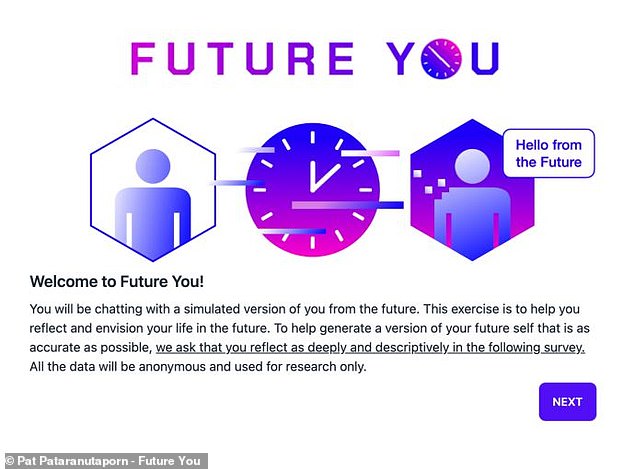While scientists have yet to invent a time machine, there is now a way for you to get some much-needed advice from your old self.
Experts at the Massachusetts Institute of Technology (MIT) have created Future You – an AI-powered chatbot that simulates a 60-year-old version of the user.
Researchers say a quick chat with your future self is just what people need to start thinking more about their decisions in the present.
With an old profile picture and a whole load of synthetic memories, the chatbot delivers believable stories about the user’s life along with sage wisdom from the future.
And, in a trial with 334 volunteers, just a short conversation with the chatbot left users feeling less anxious and more connected to their future selves.

Researchers have created an AI that lets you get advice from a future version of yourself. Future You creates a simulation of the user as they might be at age 60
So far, the Black Mirror-worthy technology has only been tested privately as part of a study, but it could be made available to the public in the coming years.
To begin conversing with their future selves, the AI first asks users a series of questions about their current life, their past, and where they might want to be in the future.
Users also feed the AI a current photo of themselves, which turns into a wrinkled, gray-haired profile picture for their next version.
Their answers are then fed into OpenAI’s ChatGPT-3.5, which generates “synthetic memories” to build a coherent story from which to answer questions.
One participant told Future You that she wanted to become a biology teacher in the future.
When she later asked her 60-year-old self about the most rewarding moment in her career, HE replied: ‘A rewarding story from my career would be the time I was able to help a struggling student get his grades back. him and pass them. biology class.’

So far, the Black Mirror-worthy technology has only been tested privately as part of a study, but it could be made available to the public in the coming years

Using the information provided, the AI creates a coherent story complete with false memories to refer back to. This diagram shows a conversation between a user and her future self about rewarding moments in her career
AI, who said she was a retired biology teacher, added: “It was so gratifying to see the student’s face light up with pride and achievement.”
Pat Pataranutaporn, who works on the Future You project at MIT’s Media Lab, says he thinks these kinds of interactions can have real benefits for users.
Pataranutaporn told The Guardian: “The aim is to promote long-term change in thinking and behaviour.
“This can motivate people to make smarter choices in the present that optimize their long-term well-being and life outcomes.”
He even says he has found benefits from talking to his future self.
In a video demonstrating the chatbot, Mr.
After a short pause, HE replies: ‘The most important lesson I have learned is that “nothing is impossible”.
“No matter how difficult something may seem, if you work hard and put your mind to it, you can achieve anything.”
Deeper, he recalls a conversation in which HE reminded him to spend time with his parents while he was still around.
“The session gave me a perspective that is still influential to me to this day,” says Mr. Patarunataporn.

Users give the AI information about themselves and a photo which is used to create synthetic memories and an outdated profile picture (pictured) for their next version
Mr. Pataranutaporn is not alone in feeling a benefit from talking to AI.
In a preprinted paper, researchers found that participants had ‘significantly reduced’ levels of negative emotions immediately after the trial.
Emotional measures revealed that participants exhibited reduced levels of anxiety as well as an increased sense of continuity with their future selves.
As the researchers note, studies have found that people who are more connected to their future selves show better mental health, academic performance and financial ability.
In their paper the researchers write: ‘Users emphasized how emotional the intervention was when commenting on the interaction, expressing positive feelings such as comfort, warmth and comfort.’
Researchers are not the first to experiment with using ‘human’ digital chatbots for mental health purposes.

The researchers found that just a brief conversation with the AI left users feeling less anxious and more connected to their future selves.
Character.ai, a chatbot used to mimic characters from games and movies, is now used by many as a popular AI therapist.
More controversially, some companies also offer so-called ‘deadbots’ or ‘griefbots’ which use AI to mimic deceased loved ones.
Platforms that offer the digital afterlife service, including The Decimal Project and After, allow users to talk to reanimated digital simulations of those who have died.
However, experts warn that these technologies can be psychologically harmful or even ‘haunt’ their users.
While the researchers found that talking to their future selves can help many people, they also warn that there are risks.
The researchers note that the risks include: ‘Incorrectly prescribing the future in a way that negatively affects current behaviour; approval of negative behaviors; and hyper-personalization that reduces real human relationships.
“Researchers need to investigate further and ensure the ethical use of this technology.”

